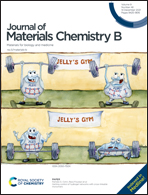Long-term cell culture and electrically in situ monitoring of living cells based on a polyaniline hydrogel sensor†
Abstract
Accurate, in situ and long-term electrically monitoring of cell development plays an important role in cell study, which brings in challenges in terms of biocompatibility, processability, and sensing capability of electrochemical sensors. Based on biocompatible conductive polyaniline (PAni) hydrogels, we constructed a flexible sensor with flexible carbon cloth for electrical analysis of living cells. The carbon fiber substrate modified with conductive PAni hydrogels was selected as the electrode to promote the current collection of the sensor. The three dimensional nanostructured mesoporous matrix of PAni hydrogels is favorable for in situ generation of catalytic Pt nanoparticles and cell growth. With these hierarchically nanostructured features, the hydrogel electrochemical sensor was endowed with high sensitivity and selectivity in the detection of H2O2 (with a low detection limit of 1.6 μM in 0.01 M PBS and a wide linear range from 10 μM to 10 mM), and good biocompatibility for cell growth as long as 5 days. The accurate detection of H2O2 released from cells enabled us to differentiate the physiological states of cells and imitate the different stimuli-responsive behavior, which can provide real-time information on cell biological events. With outstanding biocompatibility, operability and repeatability, this strategy can be expanded to the fields of other biosensor fabrication and cell-related biomarker monitoring, which exhibits a broad application potential in bioanalysis catering to new generation sensors.



 Please wait while we load your content...
Please wait while we load your content...